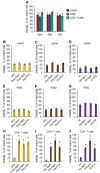Cytoprotective Activity of Polyamines Is Associated with the Alternative Splicing of RAD51A Pre-mRNA in Normal Human CD4+ T Lymphocytes
- PMID: 35163785
- PMCID: PMC8837172
- DOI: 10.3390/ijms23031863
Cytoprotective Activity of Polyamines Is Associated with the Alternative Splicing of RAD51A Pre-mRNA in Normal Human CD4+ T Lymphocytes
Abstract
Physiological polyamines are ubiquitous polycations with pleiotropic biochemical activities, including regulation of gene expression and cell proliferation as well as modulation of cell signaling. They can also decrease DNA damage and promote cell survival. In the present study, we demonstrated that polyamines have cytoprotective effects on normal human CD4+ T lymphocytes but not on cancer Jurkat or K562 cells. Pretreatment of lymphocytes with polyamines resulted in a significant reduction in cells with DNA damage induced by doxorubicin, cisplatin, or irinotecan, leading to an increase in cell survival and viability. The induction of RAD51A expression was in response to DNA damage in both cancer and normal cells. However, in normal cells, putrescin pretreatment resulted in alternative splicing of RAD51A and the switch of the predominant expression from the splice variant with the deletion of exon 4 to the full-length variant. Induction of RAD51A alternative splicing by splice-switching oligonucleotides resulted in a decrease in DNA damage and cell protection against cisplatin-induced apoptosis. The results of this study suggest that the cytoprotective activity of polyamines is associated with the alternative splicing of RAD51A pre-mRNA in normal human CD4+ T lymphocytes. The difference in the sensitivity of normal and cancer cells to polyamines may become the basis for the use of these compounds to protect normal lymphocytes during lymphoblastic chemotherapy.
Keywords: DNA damage; alternative splicing; apoptosis; cytoprotection; polyamines.
Conflict of interest statement
The authors declare no conflict of interest.
Figures







Similar articles
-
Inhibition of telomerase activity by splice-switching oligonucleotides targeting the mRNA of the telomerase catalytic subunit affects proliferation of human CD4+ T lymphocytes.Biochem Biophys Res Commun. 2019 Feb 12;509(3):790-796. doi: 10.1016/j.bbrc.2018.12.186. Epub 2019 Jan 4. Biochem Biophys Res Commun. 2019. PMID: 30612734
-
Inhibition of nuclease activity by a splice-switching oligonucleotide targeting deoxyribonuclease 1 mRNA prevents apoptosis progression and prolong viability of normal human CD4+ T-lymphocytes.Biochimie. 2020 Jul;174:34-43. doi: 10.1016/j.biochi.2020.04.009. Epub 2020 Apr 18. Biochimie. 2020. PMID: 32315661
-
[Cisplatin-induced apoptotic endonuclease EndoG inhibits telomerase activity and causes malignant transformation of human CD4+ T lymphocytes].Biomed Khim. 2017 Jan;63(1):13-26. doi: 10.18097/PBMC2017630113. Biomed Khim. 2017. PMID: 28251947 Russian.
-
Apoptotic endonuclease EndoG induces alternative splicing of Caspase-2.Biomed Khim. 2024 Aug;70(4):218-230. doi: 10.18097/PBMC20247004218. Biomed Khim. 2024. PMID: 39239896 Review.
-
Splicing in the immune system: potential targets for therapeutic intervention by antisense-mediated alternative splicing.Curr Opin Mol Ther. 2009 Apr;11(2):124-32. Curr Opin Mol Ther. 2009. PMID: 19330718 Review.
Cited by
-
Modulation of Suppressive Activity and Proliferation of Human Regulatory T Cells by Splice-Switching Oligonucleotides Targeting FoxP3 Pre-mRNA.Cells. 2023 Dec 29;13(1):77. doi: 10.3390/cells13010077. Cells. 2023. PMID: 38201281 Free PMC article.
-
Anticancer Cytotoxic Activity of Bispidine Derivatives Associated with the Increasing Catabolism of Polyamines.Molecules. 2022 Jun 16;27(12):3872. doi: 10.3390/molecules27123872. Molecules. 2022. PMID: 35744995 Free PMC article.
-
Induction of FoxP3 Pre-mRNA Alternative Splicing to Enhance the Suppressive Activity of Regulatory T Cells from Amyotrophic Lateral Sclerosis Patients.Biomedicines. 2024 May 7;12(5):1022. doi: 10.3390/biomedicines12051022. Biomedicines. 2024. PMID: 38790984 Free PMC article.
References
-
- Zarza X., Van Wijk R., Shabala L., Hunkeler A., Lefebvre M., Rodriguez-Villalón A., Shabala S., Tiburcio A.F., Heilmann I., Munnik T. Lipid kinases PIP5K7 and PIP5K9 are required for polyamine-triggered K(+) efflux in Arabidopsis roots. Plant J. 2020;104:416–432. doi: 10.1111/tpj.14932. - DOI - PMC - PubMed
MeSH terms
Substances
Grants and funding
LinkOut - more resources
Full Text Sources
Research Materials

